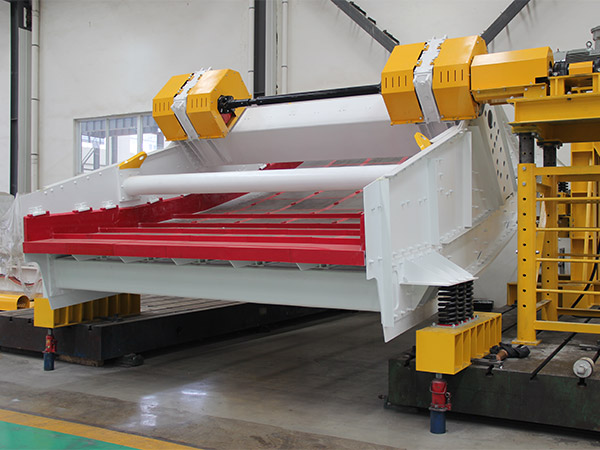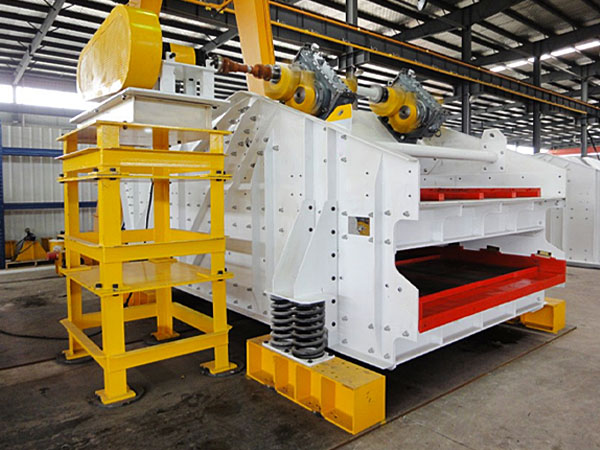What are the types of mining vibrating screens?
Mining vibrating screens are essential for separating materials based on size. They come in various designs to handle different materials, throughputs, and applications. Here’s a breakdown of the main types:
Based on Motion

Linear Motion Vibrating Screens (Inclined or Horizontal):
Mechanism: These screens vibrate in a straight line, typically driven by eccentric shafts or vibratory motors. The vibration is usually angled to the screen surface, causing material to move forward and stratify.
Inclined Linear Screens:
Description: The screen deck is positioned at an angle to the horizontal.
Advantages: Good material conveying speed, often used for initial screening and scalping.
Disadvantages: Less efficient at finer separations compared to horizontal screens.
Horizontal Linear Screens:
Description: The screen deck is horizontal or nearly horizontal.
Advantages: Better for fine separations, higher screening efficiency, less material stratification, longer retention time for better dewatering.
Disadvantages: Can require more power and may need to be installed on vibration isolators to reduce noise and vibration transfer.
Circular Motion Vibrating Screens:
Mechanism: These screens vibrate in a circular or elliptical motion. The vibratory motion is typically generated by a rotating eccentric shaft.
Description: This type provides a more aggressive screening action, better for handling sticky or difficult-to-screen materials.
Advantages: Good for coarse materials, high throughput, effective at preventing plugging and blinding.
Disadvantages: Can be less efficient for fine separations, can have higher wear due to more aggressive motion.
Elliptical Motion Vibrating Screens:
Mechanism: The vibration pattern is elliptical, combining forward and upward motion.
Description: This type offers a good compromise between linear and circular motion, providing both forward conveyance and particle stratification.
Advantages: Versatile, suitable for a range of particle sizes, good for materials that are prone to stratification.
Disadvantages: May be more complex in design and maintenance compared to linear screens.

Based on Deck Configuration:
Single-Deck Screens:
Description: Contain only one screening surface.
Use: Often used for scalping or basic size separation.
Double-Deck Screens:
Description: Contain two screening surfaces stacked on top of each other.
Use: Capable of producing three different size fractions (oversize, middlings, undersize).
Triple-Deck Screens (and beyond):
Description: Contain three or more screening surfaces stacked.
Use: Used for multiple separations in one operation.
Based on Application and Specialization:
Grizzly Screens:
Description: Heavy-duty screens with large openings, usually used for initial scalping and removing large boulders.
Use: Primarily for protecting downstream equipment from oversized material.
Dewatering Screens:
Description: Specifically designed to remove excess water from materials.
Use: Used after washing or processing to reduce moisture content. They often utilize a slightly inclined deck and rapid vibration to accelerate the dewatering process.
Banana Screens:
Description: Screens with a curved deck that is steep at the feed end and flattens out towards the discharge.
Use: Designed to handle very high material loads with good efficiency.
Flip-Flow Screens:
Description: These screens have flexible screening surfaces that are vibrated in a way that causes the screen to flex and expand, preventing blinding, particularly with damp, sticky materials.
Use: Very effective with challenging and sticky materials.
Fine Screens:
Description: Designed to handle fine particles and achieve precise size separations, they often use very fine mesh or polyurethane panels.
Use: Found in applications where very fine material is targeted, such as sand processing or mineral recovery.
Key Factors to Consider When Choosing a Vibrating Screen:

Material Size and Type: The size, shape, density, and moisture content of the material being screened will influence the choice of screen type.
Throughput Requirements: The desired capacity of the screening operation will determine the size and design of the screen.
Separation Efficiency: The precision and accuracy of separation required.
Maintenance Requirements: Ease of access for maintenance and replacement of screen media.
Cost: Initial investment and operating costs.
Space Constraints: Available area for installation.
In Conclusion:
The best type of vibrating screen depends on the specific requirements of the mining operation. Careful evaluation of the material characteristics, throughput, and desired separation outcomes is crucial in selecting the appropriate screen for optimal performance and efficiency. This breakdown should give you a solid understanding of the common types of mining vibrating screens and their applications.



